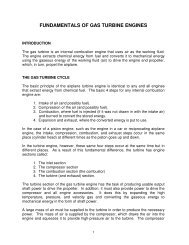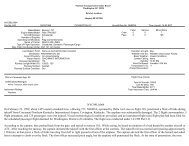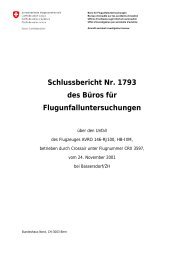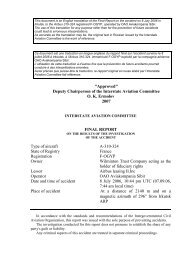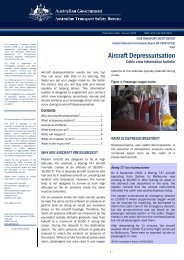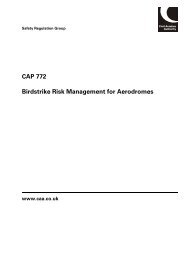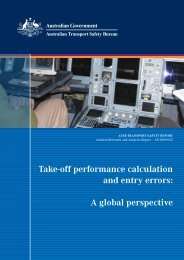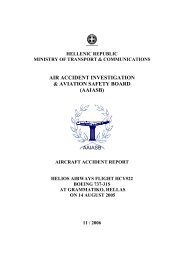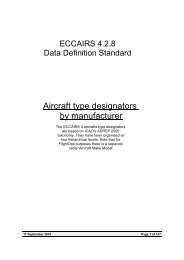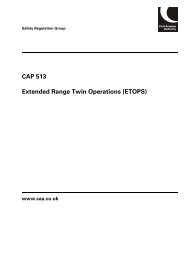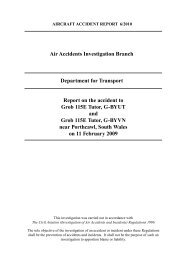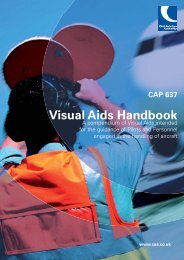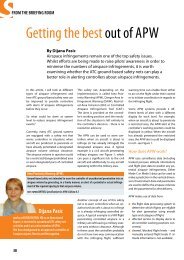CAP 730 - Safety Management Systems for Air Traffic ... - SKYbrary
CAP 730 - Safety Management Systems for Air Traffic ... - SKYbrary
CAP 730 - Safety Management Systems for Air Traffic ... - SKYbrary
You also want an ePaper? Increase the reach of your titles
YUMPU automatically turns print PDFs into web optimized ePapers that Google loves.
<strong>Safety</strong> Regulation Group<br />
<strong>CAP</strong> <strong>730</strong><br />
<strong>Safety</strong> <strong>Management</strong> <strong>Systems</strong> <strong>for</strong> <strong>Air</strong> <strong>Traffic</strong><br />
<strong>Management</strong><br />
A Guide to Implementation<br />
www.caa.co.uk
<strong>Safety</strong> Regulation Group<br />
<strong>CAP</strong> <strong>730</strong><br />
<strong>Safety</strong> <strong>Management</strong> <strong>Systems</strong> <strong>for</strong> <strong>Air</strong> <strong>Traffic</strong><br />
<strong>Management</strong><br />
A Guide to Implementation<br />
Important Note<br />
The CAA has made many of the documents that it publishes available electronically (in addition to<br />
traditional printed <strong>for</strong>mat). Where practical, the opportunity has been taken to incorporate a clearer<br />
revised appearance to the documents. Any significant changes to the content of this document will be<br />
shown in the Explanatory Note. If no such changes are indicated the material contained in this<br />
document, although different in appearance to the previously printed version, is unchanged. Further<br />
in<strong>for</strong>mation about these changes and the latest version of documents can be found at www.caa.co.uk.<br />
12 September 2002
<strong>CAP</strong> <strong>730</strong> <strong>Safety</strong> <strong>Management</strong> <strong>Systems</strong> <strong>for</strong> <strong>Air</strong> <strong>Traffic</strong> <strong>Management</strong><br />
© Civil Aviation Authority 2002<br />
ISBN 0 86039 882 X<br />
First edition 12 September 2002<br />
Enquiries regarding the content of this publication should be addressed to:<br />
<strong>Air</strong> <strong>Traffic</strong> Services Standards Department, <strong>Safety</strong> Regulation Group, Civil Aviation Authority, Aviation<br />
House, Gatwick <strong>Air</strong>port South, West Sussex, RH6 0YR.<br />
The latest version of this document is available in electronic <strong>for</strong>mat at www.caa.co.uk, where you may<br />
also register <strong>for</strong> e-mail notification of amendments.<br />
Printed copies and amendment services are available from: Documedia Solutions Ltd., 37 Windsor<br />
Street, Cheltenham, Glos., GL52 2DG.
<strong>CAP</strong> <strong>730</strong> <strong>Safety</strong> <strong>Management</strong> <strong>Systems</strong> <strong>for</strong> <strong>Air</strong> <strong>Traffic</strong> <strong>Management</strong><br />
List of Pages<br />
Part Chapter Page Date Part Chapter Page Date<br />
12 September 2002<br />
iii 12 September 2002<br />
iv 12 September 2002<br />
v 12 September 2002<br />
vi 12 September 2002<br />
Chapter 1 1 12 September 2002<br />
Chapter 1 2 12 September 2002<br />
Chapter 1 3 12 September 2002<br />
Chapter 2 1 12 September 2002<br />
Chapter 2 2 12 September 2002<br />
Chapter 3 1 12 September 2002<br />
Chapter 3 2 12 September 2002<br />
Chapter 3 3 12 September 2002<br />
Chapter 3 4 12 September 2002<br />
Chapter 3 5 12 September 2002<br />
Chapter 3 6 12 September 2002<br />
Chapter 3 7 12 September 2002<br />
Chapter 4 1 12 September 2002<br />
Annex A 1 12 September 2002<br />
Annex A 2 12 September 2002<br />
Annex B 1 12 September 2002<br />
Annex C 1 12 September 2002<br />
Annex D 1 12 September 2002<br />
Annex E 1 12 September 2002<br />
Annex F 1 12 September 2002<br />
Annex F 2 12 September 2002<br />
Annex G 1 12 September 2002<br />
Annex G 2 12 September 2002<br />
Annex G 3 12 September 2002<br />
Annex G 4 12 September 2002<br />
Annex G 5 12 September 2002<br />
Annex G 6 12 September 2002<br />
Annex G 7 12 September 2002<br />
Annex G 8 12 September 2002<br />
Annex G 9 12 September 2002<br />
Annex G 10 12 September 2002<br />
Page iii
<strong>CAP</strong> <strong>730</strong> <strong>Safety</strong> <strong>Management</strong> <strong>Systems</strong> <strong>for</strong> <strong>Air</strong> <strong>Traffic</strong> <strong>Management</strong><br />
Contents<br />
Chapter 1 Introduction<br />
List of Pages iii<br />
Bibliography v<br />
Acknowledgement vi<br />
The Benefits of a <strong>Safety</strong> <strong>Management</strong> System 1<br />
Purpose of this Guide 1<br />
What is a <strong>Safety</strong> <strong>Management</strong> System? 2<br />
The Fundamental Requirement of <strong>Safety</strong> <strong>Management</strong> 3<br />
Understanding and Implementing a <strong>Safety</strong> <strong>Management</strong> System 3<br />
Chapter 2 The Key Elements of a <strong>Safety</strong> <strong>Management</strong> System<br />
Chapter 3 Implementation<br />
Chapter 4 Conclusion<br />
SMS Essential Prerequisites 1<br />
A Comprehensive Corporate Approach to <strong>Safety</strong> 1<br />
An Effective Organisation <strong>for</strong> Delivering <strong>Safety</strong> 4<br />
<strong>Systems</strong> to Achieve <strong>Safety</strong> Oversight 6<br />
Annex A Hazard Identification and Risk Assessment Log Examples<br />
Annex B Risk Analysis<br />
Annex C Likelihood<br />
Annex D Risk Tolerability Matrix<br />
Annex E Example Terms of Reference <strong>for</strong> the <strong>Air</strong> <strong>Safety</strong> Review Board<br />
Annex F Example Terms of Reference <strong>for</strong> the <strong>Safety</strong> Action Group<br />
Annex G Guidance <strong>for</strong> Auditing a Formal <strong>Safety</strong> <strong>Management</strong> System<br />
12 September 2002<br />
Page iv
<strong>CAP</strong> <strong>730</strong> <strong>Safety</strong> <strong>Management</strong> <strong>Systems</strong> <strong>for</strong> <strong>Air</strong> <strong>Traffic</strong> <strong>Management</strong><br />
Bibliography<br />
1 <strong>CAP</strong> 712 <strong>Safety</strong> <strong>Management</strong> <strong>Systems</strong> <strong>for</strong> Commercial <strong>Air</strong> Transport Operations<br />
2 <strong>Safety</strong> <strong>Management</strong> <strong>Systems</strong> – Operating Standards Division Guidelines (version 1.6<br />
last revised 10 Dec 1998)<br />
3 ICAO Document 9422 (Accident Prevention Manual)<br />
4 SMS leaflet as distributed to CAA’s Industry Conference 24 May 2000<br />
5 Policy Document: Aviation <strong>Safety</strong> <strong>Management</strong> System – UK Flight <strong>Safety</strong> Committee<br />
6 Guide to a <strong>Safety</strong> <strong>Management</strong> System – UK Flight <strong>Safety</strong> Committee<br />
7 Draft Guidance Material – UK SMS Combined Action Group<br />
8 SMS requirements document Version 5.0 – SRG <strong>Air</strong>craft Maintenance Standards<br />
Department<br />
9 Pro-<strong>for</strong>ma – British Regional <strong>Air</strong> Lines Group<br />
10 Making the <strong>Safety</strong> Case – Shell <strong>Air</strong>craft Ltd<br />
11 The ‘Three Prerequisites’ approach to safety management described in this document<br />
is based on the concept first developed by Mike Overall.<br />
12 September 2002<br />
‘<strong>Safety</strong> <strong>Management</strong> – From Theory into Practice: Making it Happen’ – paper<br />
presented by Mike Overall to the International <strong>Air</strong> <strong>Safety</strong> Seminar, Capetown,<br />
November 1998.<br />
‘Managing <strong>Safety</strong> <strong>Management</strong>’ – presentation by Mike Overall to the UK Flight<br />
<strong>Safety</strong> Committee Seminar, October 2000.<br />
Page v
<strong>CAP</strong> <strong>730</strong> <strong>Safety</strong> <strong>Management</strong> <strong>Systems</strong> <strong>for</strong> <strong>Air</strong> <strong>Traffic</strong> <strong>Management</strong><br />
Acknowledgement<br />
The original text of this guide was prepared and published through the work of the <strong>Air</strong><br />
Transport Operations – <strong>Safety</strong> <strong>Management</strong> Group (ATO-SMG). The ATS Standards<br />
Department of the CAA have taken the view that the text is largely generic and with a few<br />
cosmetic changes offers benefits of standardization and consistency to the entire aviation<br />
community. With this objective in mind every ef<strong>for</strong>t will be made to sustain commonality of<br />
approach and understanding in any future guidance.<br />
ATS Standards Department <strong>for</strong>mally acknowledges the key contribution made by ATO-SMG<br />
and thanks them <strong>for</strong> making this guidance available.<br />
The <strong>Air</strong> Transport Operations – <strong>Safety</strong> <strong>Management</strong> Group<br />
The names and affiliations of the members of the <strong>Air</strong> Transport Operations – <strong>Safety</strong><br />
<strong>Management</strong> Group (ATO-SMG) are listed below. ATO-SMG was <strong>for</strong>med in early 2000 during<br />
which year the Group held a number of meetings. Through their representatives on ATO-SMG,<br />
members of the UK Flight <strong>Safety</strong> Committee, the UK <strong>Safety</strong> <strong>Management</strong> System Combined<br />
Action Group and the CAA’s <strong>Safety</strong> Regulation Group were kept appraised of progress. Final<br />
drafts of the Guide were extensively critiqued by people in those organisations.<br />
UK Flight <strong>Safety</strong> Committee:<br />
Ed Pooley, Head of <strong>Safety</strong>, British Regional <strong>Air</strong> Lines Group plc and Mel Grievson, General<br />
Manager Flight <strong>Safety</strong> & Quality, British Midland. At the end of 2000, Martin Pitt, Flight <strong>Safety</strong><br />
Officer, <strong>Air</strong> 2000 took over as the second UKFSC representative, Mel Grievson continuing as<br />
an independent co-opted member.<br />
The United Kingdom Flight <strong>Safety</strong> Commitee (UKFSC) was founded in 1957 and is a<br />
membership organisation dedicated to the furtherance of air safety in its widest sense.<br />
Members are drawn from civil and military air transport operators, the air traffic service<br />
community, aircraft maintenance organisations, airport operators, aircraft and aircraft systems<br />
manufacturers, employee associations, insurance agencies and <strong>Safety</strong> Regulators supported<br />
by a number of co-opted expert advisers and a full time Secretariat.<br />
UK <strong>Safety</strong> <strong>Management</strong> System Combined Action Group:<br />
Cliff Edwards, Quality and <strong>Safety</strong> Development Manager, Shell <strong>Air</strong>craft and Simon Witts,<br />
Technical Director, British Regional <strong>Air</strong> Lines Group plc.<br />
The UK <strong>Safety</strong> <strong>Management</strong> System Combined Action Group is a voluntary grouping of UK<br />
Engineering & Maintenance related interested parties with a mutual interest in promoting the<br />
adoption of <strong>Safety</strong> <strong>Management</strong> <strong>Systems</strong> in the UK <strong>Air</strong> Transport Industry.<br />
CAA – <strong>Safety</strong> Regulation Group:<br />
Jim Done, Head of <strong>Air</strong>craft Maintenance Standards Department and David Orringe, Quality<br />
Manager, Flight Operations Department.<br />
ATO-SMG Chairman:<br />
Peter Hunt, Head of Operating Standards Division, SRG.<br />
12 September 2002<br />
Page vi
<strong>CAP</strong> <strong>730</strong> <strong>Safety</strong> <strong>Management</strong> <strong>Systems</strong> <strong>for</strong> <strong>Air</strong> <strong>Traffic</strong> <strong>Management</strong><br />
Chapter 1 Introduction<br />
JAR–OPS states that ‘an operator shall establish an accident prevention and flight<br />
safety programme, which may be integrated with the Quality System, including<br />
programmes to achieve and maintain risk awareness by all persons involved in<br />
operations’. This statement is based on the ICAO recommended practice (Annex 6<br />
Part 1) <strong>for</strong> operators to have such a programme in place. ICAO Document 9422<br />
(Accident Prevention Manual) gives appropriate guidance material and describes a<br />
<strong>Safety</strong> <strong>Management</strong> System.<br />
In early 1999, following industry consultation, the UK Civil Aviation Authority’s <strong>Safety</strong><br />
Regulation Group (SRG) published an introductory document regarding <strong>Safety</strong><br />
<strong>Management</strong> <strong>Systems</strong> (Bibliography: 1). The discussion that followed publication of<br />
the SRG document demonstrated the need <strong>for</strong> additional material to assist both the<br />
newcomer and the more experienced with the practicalities of <strong>Safety</strong> <strong>Management</strong><br />
System (SMS) implementation.<br />
In this Guide, full account is taken of the need to maintain safety risks as low as<br />
reasonably practicable. SRG policies are incorporated and provide commonality of<br />
approach with disciplines other than operations and maintenance. This document<br />
concerns the principles of managing aviation safety but many of the principles to be<br />
described also apply to occupational health and safety management.<br />
1 The Benefits of a <strong>Safety</strong> <strong>Management</strong> System<br />
To improve on existing levels of aviation safety in the light of the continuing growth<br />
of the industry, additional measures are needed. One such measure is to encourage<br />
individual operators to introduce their own <strong>Safety</strong> <strong>Management</strong> System. Such a<br />
system is as important to business survival as a financial management system and<br />
the implementation of a <strong>Safety</strong> <strong>Management</strong> System should lead to achievement of<br />
one of civil aviation’s key business goals: enhanced safety per<strong>for</strong>mance aiming at<br />
best practice and moving beyond mere compliance with regulatory requirements.<br />
2 Purpose of this Guide<br />
2.1 The guide is derived directly from original work by the operating and maintenance<br />
sectors of the UK civil aviation industry. The <strong>Air</strong> Transport Operations – <strong>Safety</strong><br />
<strong>Management</strong> Group (ATO-SMG), a joint UK Industry/Civil Aviation Authority working<br />
group was <strong>for</strong>med. The Group’s task was to develop guidance material <strong>for</strong><br />
commercial air transport operators and maintenance organisations which will assist<br />
them to develop effective and comprehensive systems <strong>for</strong> managing safety. The<br />
principles and practices determined from this work are considered to provide generic<br />
guidance suitable <strong>for</strong> ATM.<br />
2.2 This Guide, focusing on ATM activities, sets out to in<strong>for</strong>m and aid the reader such that<br />
an effective SMS can be developed <strong>for</strong> managing safety appropriate to the size and<br />
scope of any particular organisation. The Guide will answer three questions:<br />
• What is a SMS?<br />
• What is it expected to achieve? and<br />
• How do we go about implementing and maintaining such a system?<br />
12 September 2002<br />
Chapter 1 Page 1
<strong>CAP</strong> <strong>730</strong> <strong>Safety</strong> <strong>Management</strong> <strong>Systems</strong> <strong>for</strong> <strong>Air</strong> <strong>Traffic</strong> <strong>Management</strong><br />
2.3 By relating the guidance to existing systems in their companies, organisations will be<br />
able to <strong>for</strong>mulate a view on the likely financial costs of implementation of SMS<br />
principles. Given the benefits, any incremental costs make sound business – as well<br />
as safety – sense.<br />
2.4 This Guide builds on earlier work on the management of safety by offering practical<br />
guidance material <strong>for</strong> ATM service providers to assist with the development of<br />
effective systems <strong>for</strong> managing safety. The guidance produced is also intended to<br />
cover the development of measures necessary to ensure that any safety-related<br />
interfaces between air operators, maintenance organisations and their respective<br />
suppliers and sub-contractors are managed in accordance with sound safety<br />
management principles.<br />
3 What is a <strong>Safety</strong> <strong>Management</strong> System?<br />
3.1 We begin with two definitions appropriate to ATM:<br />
‘<strong>Safety</strong> <strong>Management</strong>’ is defined as the systematic management of the risks<br />
associated with ATM activities to achieve high levels of safety per<strong>for</strong>mance.<br />
A ‘<strong>Safety</strong> <strong>Management</strong> System’ is an explicit element of the corporate<br />
management responsibility which sets out a company’s safety policy and defines<br />
how it intends to manage safety as an integral part of its overall business.<br />
3.2 A <strong>Safety</strong> <strong>Management</strong> System can be compared with a financial management<br />
system as a method of systematically managing a vital business function. It is<br />
instructive to look briefly at this aspect.<br />
3.2.1 The features of a financial management system are well recognised. Financial targets<br />
are set, budgets are prepared, levels of authority are established and so on. The<br />
<strong>for</strong>malities associated with a financial management system include ‘checks and<br />
balances’. The whole system includes a monitoring element so that corrections can<br />
be made if per<strong>for</strong>mance falls short of set targets.<br />
3.2.2 The outputs from a financial management system are usually felt across the<br />
company. Risks are still taken but the finance procedures should ensure that there are<br />
no ‘business surprises’. If there are, it can be disastrous <strong>for</strong> a small company. For the<br />
larger company, unwelcome media attention usually follows an unexpected loss.<br />
3.2.3 An aircraft accident is also ‘an unexpected loss’ and not one that any company in the<br />
civil aviation industry wishes to suffer. It should be apparent that the management of<br />
safety must attract at least the same focus as that of finance. The adoption of an<br />
effective <strong>Safety</strong> <strong>Management</strong> System will provide this.<br />
3.2.4 A developed SMS provides a transparent, recorded system to manage safety and<br />
deserves at least the same degree of care that would be applied to a financial<br />
management system.<br />
3.3 A similar argument applies to a comparison with Quality <strong>Management</strong>, which should<br />
interface with <strong>Safety</strong> <strong>Management</strong> as part of the organisation’s core management<br />
system.<br />
12 September 2002<br />
Chapter 1 Page 2
<strong>CAP</strong> <strong>730</strong> <strong>Safety</strong> <strong>Management</strong> <strong>Systems</strong> <strong>for</strong> <strong>Air</strong> <strong>Traffic</strong> <strong>Management</strong><br />
4 The Fundamental Requirement of <strong>Safety</strong> <strong>Management</strong><br />
Success in a company’s safety per<strong>for</strong>mance will be greatly strengthened by the<br />
existence of a positive safety culture. <strong>Safety</strong> culture in an organisation can be<br />
described as the way in which it conducts its business and particularly in the way it<br />
manages safety. It emanates from the communicated principles of top management<br />
and results in all staff exhibiting a safety ethos which transcends departmental<br />
boundaries. It can be measured by in<strong>for</strong>mal or <strong>for</strong>mal staff surveys, or by observations<br />
conducted in safety-related work areas. <strong>Safety</strong> must be actively managed from the<br />
very top of a company. <strong>Safety</strong> management must be seen as an integral strategic<br />
aspect of business management, recognising the high priority attached by the<br />
company to safety. To that end, a demonstrable Board-level commitment to an<br />
effective <strong>for</strong>mal <strong>Safety</strong> <strong>Management</strong> System must exist. Equally, every level of<br />
management must be given a safety accountability. The contribution of the staff at<br />
and below supervisor level must be emphasised.<br />
5 Understanding and Implementing a <strong>Safety</strong> <strong>Management</strong> System<br />
5.1 Four points must be made at the outset, to indicate that implementation of a SMS<br />
involves evolution rather than revolution.<br />
• Companies establishing a SMS need to take a pragmatic approach, building where<br />
possible on existing procedures and practices (particularly Quality <strong>Management</strong>).<br />
SMS identifies and prioritises the use of resources to manage risk and it should<br />
lead to gains in efficiency.<br />
• Adoption of ‘best practice’ standards must be the goal.<br />
• A fully-fledged SMS is a <strong>for</strong>malised, company-wide system. Established at the<br />
corporate level, the SMS then devolves out into the individual departments of the<br />
company. Operations, Engineering, En-Route, Aerodromes and all other<br />
departments whose activities contribute to the service providers safety<br />
per<strong>for</strong>mance will have their own processes and procedures under the umbrella of<br />
the corporate SMS.<br />
• Where safety sensitive functions of the operator are outsourced, contractual<br />
agreements should identify the need <strong>for</strong> equivalent, auditable SMS in the supplier.<br />
5.2 Many existing procedures and practices are reactive, i.e. they are put in place<br />
following a safety event. SMS is both proactive and reactive, giving a means to<br />
anticipate and prevent or reduce the effect of risks. This is the essential benefit of<br />
<strong>Safety</strong> working in partnership with Quality <strong>Management</strong>.<br />
5.3 Successful development of SMS in a company follows an initial approach to the task;<br />
preparation <strong>for</strong> and implementation of SMS and, finally, the assurance of continued<br />
success of the system.<br />
5.4 Unless ‘starting from scratch’, it is not necessary to adhere to any particular sequence<br />
of actions. Many – perhaps all – operators will find that their existing processes and<br />
procedures can be linked into the framework of a <strong>for</strong>mal SMS.<br />
5.5 The rest of this Guide is given over to an explanation of the SMS philosophy followed<br />
by practical advice on the establishment of a SMS. Section 2 explains the key<br />
elements of a SMS. Section 3 details the implementation of those elements.<br />
12 September 2002<br />
Chapter 1 Page 3
<strong>CAP</strong> <strong>730</strong> <strong>Safety</strong> <strong>Management</strong> <strong>Systems</strong> <strong>for</strong> <strong>Air</strong> <strong>Traffic</strong> <strong>Management</strong><br />
Chapter 2 The Key Elements of a <strong>Safety</strong> <strong>Management</strong><br />
System<br />
1 SMS Essential Prerequisites<br />
There are three essential prerequisites <strong>for</strong> a <strong>Safety</strong> <strong>Management</strong> System. These are:<br />
• a comprehensive corporate approach to safety;<br />
• an effective organisation <strong>for</strong> delivering safety; and<br />
• systems to achieve safety oversight.<br />
Each will now be considered in outline, the details being presented in Chapter 3 to<br />
this document.<br />
1.1 A Comprehensive Corporate Approach to <strong>Safety</strong><br />
An effective SMS will provide a means of achieving enhanced safety per<strong>for</strong>mance<br />
which meets or exceeds basic compliance with the regulatory requirements<br />
associated with safety and quality. Enhanced safety per<strong>for</strong>mance is founded upon a<br />
proactive safety culture inherent in all the company’s safety-related activities. It is<br />
achieved by effective, devolved executive management in association with a means<br />
of independent safety oversight, both of which are the ultimate responsibility of the<br />
organisation’s Board and Chief Executive Officer (CEO). The Board and CEO are then<br />
able to demonstrate how safety is managed in the company to the owners;<br />
work<strong>for</strong>ce; shareholders; safety regulatory authorities and customers.<br />
A corporate approach to safety must be able to meet the following criteria:<br />
• published safety accountabilities of managers and key staff;<br />
• requirements <strong>for</strong> a safety manager;<br />
• the ability to demonstrate that it generates a positive safety culture throughout the<br />
organisation;<br />
• documented business policies, principles and practices in which safety is inherent;<br />
• commitment to a safety oversight process which is independent of line<br />
management;<br />
• regularly reviewed safety improvement plans;<br />
• <strong>for</strong>mal safety review processes.<br />
1.2 An Effective Organisation <strong>for</strong> Delivering <strong>Safety</strong><br />
The second essential prerequisite is <strong>for</strong> an organisation that delivers safe standards<br />
by way of:<br />
• effective arrangements <strong>for</strong> selection, recruitment, development and training of<br />
staff;<br />
• safety awareness training <strong>for</strong> management and staff;<br />
• defined standards <strong>for</strong>, and auditing of, asset purchases and contracted services;<br />
• controls <strong>for</strong> the early detection of – and action on – deterioration in the<br />
per<strong>for</strong>mance of safety-significant equipment or systems or services;<br />
• controls <strong>for</strong> monitoring and recording the overall safety standards of the company;<br />
12 September 2002<br />
Chapter 2 Page 1
<strong>CAP</strong> <strong>730</strong> <strong>Safety</strong> <strong>Management</strong> <strong>Systems</strong> <strong>for</strong> <strong>Air</strong> <strong>Traffic</strong> <strong>Management</strong><br />
• the application of appropriate hazard identification, risk assessment and effective<br />
management of resources to control those risks;<br />
• change management;<br />
• arrangements enabling staff to communicate significant safety concerns to the<br />
appropriate level of management <strong>for</strong> resolution and feedback of actions taken;<br />
• emergency response planning and simulated exercises to test its effectiveness;<br />
• assessment of commercial policies with regard to impact on safety.<br />
1.3 <strong>Systems</strong> to Achieve <strong>Safety</strong> Oversight<br />
The following elements are desirable:<br />
• a system <strong>for</strong> analysing flight recorder data <strong>for</strong> the purpose of monitoring flight<br />
operations and <strong>for</strong> detecting unreported safety events;<br />
• a company-wide system <strong>for</strong> the capture of written safety event/issue reports;<br />
• a planned and comprehensive safety audit review system which has the flexibility<br />
to focus on specific safety concerns as they arise;<br />
• a published system <strong>for</strong> the conduct of internal safety investigations, the<br />
implementation of remedial actions and the communication of such in<strong>for</strong>mation;<br />
• systems <strong>for</strong> effective use of safety data <strong>for</strong> per<strong>for</strong>mance analysis and <strong>for</strong><br />
monitoring organisational change as part of the risk management process;<br />
• arrangements <strong>for</strong> ongoing safety promotion based on the measured internal safety<br />
per<strong>for</strong>mance and assimilation of experience of other operations;<br />
• periodic review of the continued effectiveness of the safety management system<br />
by an internal, independent body;<br />
• line manager’s monitoring of work in progress in all safety critical activities to<br />
confirm compliance with all regulatory requirements, company standards and local<br />
procedures.<br />
Chapter 3, which follows, discusses the three essential prerequisites <strong>for</strong><br />
implementing <strong>Safety</strong> <strong>Management</strong> in detail.<br />
12 September 2002<br />
Chapter 2 Page 2
<strong>CAP</strong> <strong>730</strong> <strong>Safety</strong> <strong>Management</strong> <strong>Systems</strong> <strong>for</strong> <strong>Air</strong> <strong>Traffic</strong> <strong>Management</strong><br />
Chapter 3 Implementation<br />
Introduction<br />
Chapters 1 and 2 give essential in<strong>for</strong>mation regarding the background and elements<br />
of a SMS but the key to success is in the implementation. To ensure its success, it is<br />
considered to be beneficial to approach this in three stages which should, if properly<br />
implemented, provide a closed-loop system of sustaining the cultural and procedural<br />
change necessary:<br />
Stage 1 – A comprehensive approach to safety<br />
Stage 2 – An effective organisation <strong>for</strong> delivering safety<br />
Stage 3 – <strong>Systems</strong> to achieve safety oversight<br />
1 A Comprehensive Corporate Approach to <strong>Safety</strong><br />
1.1 Published <strong>Safety</strong> Accountabilities<br />
Successful handling of safety matters is a line responsibility, requiring the active<br />
participation of all levels of management and supervision. This should be reflected in<br />
the structure of the company and in published safety accountabilities. The company<br />
should define, document, and communicate – with the aid of organisational diagrams<br />
where appropriate – responsibilities, accountabilities, and authorities. The company<br />
should stress to all employees their individual and collective responsibilities and<br />
accountabilities <strong>for</strong> safety per<strong>for</strong>mance. Top-level accountabilities may not be<br />
delegated, but should be cascaded throughout the company so that all aspects of<br />
aviation safety are covered without gaps.<br />
1.2 <strong>Safety</strong> Manager<br />
1.2.1 In most small and medium sized companies it is expected that the Flight <strong>Safety</strong> and<br />
Quality tasks will have many common points and there can be no objection to the<br />
combination of the roles in one staff member. This ‘safety manager’ must have a<br />
direct reporting line, on safety matters, to the CEO (the person who directs and<br />
controls the organisation at the highest level – accountable manager). It is important<br />
that this person has the respect of the staff from the shop floor up to the senior<br />
management, yet is able to be objective in the fulfillment of his/her <strong>Safety</strong><br />
<strong>Management</strong> task. The appointed <strong>Safety</strong> Manager would be expected to:<br />
• hold or have held a relevant licence;<br />
• have relevant operational or maintenance experience;<br />
• have undertaken <strong>Safety</strong> <strong>Management</strong> and accident investigator training;<br />
• have the respect of the organisation.<br />
He would also need to draw on appropriate expertise from other disciplines as<br />
required.<br />
12 September 2002<br />
Chapter 3 Page 1
<strong>CAP</strong> <strong>730</strong> <strong>Safety</strong> <strong>Management</strong> <strong>Systems</strong> <strong>for</strong> <strong>Air</strong> <strong>Traffic</strong> <strong>Management</strong><br />
1.2.2 The safety manager must have clear responsibilities e.g:<br />
• management of the <strong>Safety</strong> Improvement Plan;<br />
• the facilitation of hazard management and risk assessment;<br />
• advice to managers on safety matters;<br />
• the Emergency Response plan;<br />
• investigation of incidents and accidents;<br />
• dissemination of appropriate safety in<strong>for</strong>mation;<br />
• staff training in safety and quality management;<br />
• control of safety and quality documentation;<br />
• facilitation of <strong>Safety</strong> Review Board and <strong>Safety</strong> Action Group meetings.<br />
1.3 Positive <strong>Safety</strong> Culture<br />
The commitment of a company’s top management (those who direct and control the<br />
organisation at the highest level) towards safety, safety practices and safety oversight<br />
will determine how business is conducted from a safety standpoint. The safety<br />
culture of the company underpins the entire safety achievement of the company and<br />
is crucial to its success. The ideal safety culture is one that is supportive of the staff<br />
and systems of work, recognises that errors will be made and that it is not<br />
apportionment of blame that will resolve the problems. There<strong>for</strong>e, the supportive<br />
culture will encourage open reporting, seek to learn from its failures and be just in<br />
dealing with those involved. Punitive action must not follow automatically from the<br />
open acknowledgement of human error. However, it must be made clear that<br />
indemnity will not be guaranteed where there has been gross negligence. The front<br />
line defence is that operating staff must not accept unsafe behaviour from their peers.<br />
1.4 Documentation of Business Policies and Practices<br />
1.4.1 The safety policies of a company define the senior management’s intentions in safety<br />
matters. These policies document the fundamental approach to be taken by staff and<br />
contractors towards safety. The policies should be based on a clear and genuine<br />
Board-level commitment that, <strong>for</strong> the company, the management of aviation safety is<br />
paramount. To this is added a commitment to best practice and compliance with<br />
aviation regulations. The achievement of the policies can be implemented through<br />
suitable organisational arrangements and management systems. These provide the<br />
focus <strong>for</strong> all staff to enact their management’s policies. The administrative<br />
arrangements that are in place <strong>for</strong> Quality <strong>Management</strong> should be used to provide the<br />
audit and follow-up process required by <strong>Safety</strong> <strong>Management</strong>.<br />
1.4.2 As a minimum the following should be published:<br />
• the safety policy statement by the CEO;<br />
• the structure of the SMS (organogram);<br />
• the responsibilities of the <strong>Safety</strong> Review Board, the <strong>Safety</strong> Action Group and the<br />
<strong>Safety</strong> Manager;<br />
• the safety accountability of each position having a safety responsibility;<br />
• the company’s system <strong>for</strong> hazard identification and risk assessment;<br />
• the safety data capture system and its confidentiality;<br />
12 September 2002<br />
Chapter 3 Page 2
<strong>CAP</strong> <strong>730</strong> <strong>Safety</strong> <strong>Management</strong> <strong>Systems</strong> <strong>for</strong> <strong>Air</strong> <strong>Traffic</strong> <strong>Management</strong><br />
• the remedial action process;<br />
• the policy on records to be maintained.<br />
1.5 Independent <strong>Safety</strong> Oversight Process<br />
1.5.1 An independent oversight programme is much like a Quality Assurance programme,<br />
but is focused on the safe per<strong>for</strong>mance of the process under review rather than<br />
simple compliance. It is necessary <strong>for</strong> the staff doing the safety oversight to have an<br />
understanding of the process under review, indeed ideally be qualified to carry out the<br />
function, whilst being fully independent of it during the audit. An example of this is a<br />
line or route check carried out from the third seat in the cockpit, as opposed to such<br />
a check carried out by the checking captain who is part of the operating crew.<br />
1.5.2 The controls that have been identified to manage the process safely should be<br />
checked <strong>for</strong> their use and effectiveness. Shortfalls against the expected standard<br />
must be <strong>for</strong>mally reported through the remedial action process, <strong>for</strong> line<br />
management’s consideration or action.<br />
1.6 Regularly Reviewed <strong>Safety</strong> Plans<br />
A <strong>Safety</strong> Improvement Plan describes how a company will achieve its corporate<br />
safety objectives and targets and how it will meet any new or revised safety<br />
requirements, regulatory or otherwise. Significant items in the <strong>Safety</strong> Plan will<br />
normally be included in the corporate business plan. A <strong>Safety</strong> Plan, which may consist<br />
of more than one document, details the actions to be taken, by whom and in what<br />
time-scale.<br />
1.7 Formal <strong>Safety</strong> Review Processes<br />
There are two distinct functions within the SMS. First, there should be a <strong>for</strong>mal board<br />
(e.g. <strong>Air</strong> <strong>Safety</strong> Review Board (ASRB) – see Annex E) to ensure that the SMS<br />
functions correctly, so that all risks are properly addressed in a timely manner.<br />
Second, there should be a body to support the risk assessment process (e.g. <strong>Safety</strong><br />
Action Group (SAG) – see Annex F) and other safety-related tasks. The first body<br />
should be at top management level: the second would lie in the line manager’s area.<br />
• The ASRB is the company's highest-level internal safety-related meeting and<br />
should be chaired by the CEO (or a non-executive director with the CEO in<br />
attendance) and include the safety manager. <strong>Safety</strong> per<strong>for</strong>mance and<br />
achievements are periodically reviewed and the results of safety and quality audits<br />
and monitoring programmes are addressed. The Board is established to ensure<br />
that the objectives and specified actions in the <strong>Safety</strong> Plan are achieved in a timely<br />
manner. Consideration may be given to any issues that are blocking progress. The<br />
allocation of resources, commitment <strong>for</strong> new initiatives and the establishment of<br />
a clear safety policy are issues that may also be resolved. Example Terms of<br />
Reference <strong>for</strong> the ASRB are shown at Annex E.<br />
• The SAGs comprise a representative selection of the line management and<br />
supervisory staff of all sections of the company (not only operations and<br />
maintenance, but also other disciplines, such as financial and commercial). In a<br />
large company there may be more than one SAG. These groups should meet<br />
periodically to support the line with the assessment of risks faced by the company<br />
and to suggest methods of mitigation. They should also support the systematic<br />
review of safety-related standards and procedures used in the company. The<br />
working of the group should be facilitated, but not directed, by the <strong>Safety</strong> Manager.<br />
This group should be used to provide experienced advice on the major aviation<br />
safety issues. Example Terms of Reference <strong>for</strong> the SAG are shown at Annex F.<br />
12 September 2002<br />
Chapter 3 Page 3
<strong>CAP</strong> <strong>730</strong> <strong>Safety</strong> <strong>Management</strong> <strong>Systems</strong> <strong>for</strong> <strong>Air</strong> <strong>Traffic</strong> <strong>Management</strong><br />
2 An Effective Organisation <strong>for</strong> Delivering <strong>Safety</strong><br />
2.1 Arrangements <strong>for</strong> Selection, Recruitment, Development and Training<br />
The objectives of selection, recruitment, development and training are to improve<br />
safety, quality and efficiency by placing employees in jobs to which they are suited<br />
and qualified. Although obvious, this is so fundamental at all levels within a company<br />
that it is worthy of emphasis. Responsibilities <strong>for</strong> safety can only be determined<br />
according to the level of competence and training of the staff member concerned.<br />
The appropriate experience and training requirements <strong>for</strong> safety-related posts must<br />
be defined, monitored and recorded. All induction and ab initio training, including that<br />
of contract staff, should explain the company’s safety culture and describe the SMS<br />
operated.<br />
2.2 <strong>Safety</strong> Awareness Training <strong>for</strong> <strong>Management</strong> and Staff<br />
A company should have processes to monitor, maintain and, where required,improve<br />
upon the competence of its managers and staff especially in relation to aviation<br />
safety. Competency and subsequent refresher training may be provided through<br />
<strong>for</strong>mal courses and/or through structured development in the workplace. Appropriate<br />
training records should be maintained. All of the <strong>for</strong>egoing is further enhanced by dayto-day<br />
safety awareness demonstrated by senior management.<br />
2.3 Defined Standards and Auditing of Asset Purchases and Contracted Services<br />
2.3.1 Contracted services or products can have a dramatic effect on the company and<br />
there<strong>for</strong>e standards need to be clearly defined at the outset. Purchasing policies must<br />
include controls to ensure the maintenance of safety standards. The purchasing<br />
control system should include the requirement that all new products, equipment,<br />
materials and services are reviewed to ensure that safety requirements are met.<br />
2.3.2 An item of particular importance to any company is the procurement of services from<br />
contractors. Contractor selection procedures should include a review of the<br />
contractor's safety management arrangements and consideration of the contractor's<br />
previous safety record. These factors should be given equal weight with other<br />
considerations such as quality and prompt completion. The contractor should be<br />
made aware of the requirements of the company's <strong>Safety</strong> <strong>Management</strong> System and<br />
their responsibilities within it. One such requirement will be a routine audit of the<br />
services provided, this being carried out by the company or its representatives.<br />
Be<strong>for</strong>e the commencement of work and throughout the contract, close liaison should<br />
be maintained to ensure that safety standards are observed.<br />
2.4 Monitoring Per<strong>for</strong>mance of <strong>Safety</strong> Significant Equipment, <strong>Systems</strong> or Services<br />
Planning <strong>for</strong> safety includes making physical resources available when needed.<br />
Clearly, such resources must function correctly. The provision and maintenance of<br />
properly engineered facilities and equipment is there<strong>for</strong>e an integral part of a <strong>Safety</strong><br />
<strong>Management</strong> System.<br />
2.5 Recording and Monitoring <strong>Safety</strong> Standards<br />
A company’s safety standards are the baseline against which all safety critical<br />
activities should be measured. Once established, it is necessary routinely to confirm<br />
that operations are in compliance with these standards. This is normally done by the<br />
establishment of a safety audit programme. It is the responsibility of the line manager<br />
to confirm that working practices comply with the appropriate requirement.<br />
12 September 2002<br />
Chapter 3 Page 4
<strong>CAP</strong> <strong>730</strong> <strong>Safety</strong> <strong>Management</strong> <strong>Systems</strong> <strong>for</strong> <strong>Air</strong> <strong>Traffic</strong> <strong>Management</strong><br />
2.6 Hazard Analysis and Risk Assessment Tools<br />
Mention has frequently been made in this Guide of the importance of a proactive – as<br />
well as reactive – approach to the management of safety. Hazard identification and<br />
risk management are proactive methods in that they are the systematic examination<br />
of potentially hazardous activities to establish safe, effective procedures and<br />
practices. Analysis of hazardous activities will identify areas of relatively higher risk<br />
that require monitoring. This enables defences to be developed and contingency<br />
plans to be produced and implemented.<br />
2.6.1 Hazard Analysis<br />
The effective identification of hazards can be achieved by brainstorming, using an<br />
appropriate selection of management and staff; staff surveys and a review of<br />
pertinent accidents/incident records from both internal and external sources. Hazard<br />
identification should be initially undertaken to provide a comprehensive assessment<br />
of the risks that face a company. Subsequently, hazard identification should be<br />
periodically reviewed. The process should also be repeated whenever there is a<br />
significant change to the organisation, its staff, procedures or equipment. Example<br />
Hazard Logs are at Annex A. It should be noted that the Log identifies the manager<br />
in whose area the risk lies. The line manager has the responsibility <strong>for</strong> setting in place<br />
measures to remove, or mitigate the risks of, the identified hazard. The <strong>Safety</strong> Action<br />
Group will monitor the completion of this task.<br />
2.6.2 Risk Assessment Tools<br />
2.6.2.1 The <strong>Safety</strong> Action Group should ensure that the line management has considered and<br />
assessed all hazards to the organisation. Risk assessment is assumed to be primarily<br />
a subjective, qualitative method of evaluation of the likelihood and severity of damage<br />
inherent in the identified hazard. Using the matrix in Annex B, those undertaking the<br />
risk assessments can prioritise the risks identified and there<strong>for</strong>e aid the line<br />
management to prioritise resources to mitigate their effects. However, an operator<br />
may prefer to undertake a more analytical, quantitative, objective approach, which is<br />
beyond the scope of this guide. The chosen method must be clearly recorded in the<br />
SMS documentation.<br />
2.6.2.2 Hazard analysis and risk assessment processes may appear complex at first sight but<br />
experience has shown that familiarity is soon gained. These processes also produce<br />
benefits <strong>for</strong> many other areas of the <strong>Safety</strong> <strong>Management</strong> System and increase<br />
efficiency. Simple examples of these processes are at Annexes A – D.<br />
NOTE: A hazard is an event that has the potential to result in damage or injury. The<br />
degree of risk is based on the likelihood that damage or harm will result from<br />
the hazard and the severity of the consequences. It is the responsibility of<br />
the line managers to carry out risk assessments. It would be the function of<br />
the <strong>Safety</strong> Action Group to review them.)<br />
2.7 Change <strong>Management</strong><br />
Effective change management is another important aspect of safety management.<br />
There is a risk of confusion whenever change is introduced to an existing system;<br />
operational requirement; maintenance process, and/or procedure. Such a risk must<br />
be recognised and any change managed in co-operation with the affected work areas.<br />
2.8 Arrangements <strong>for</strong> Staff to Communicate Significant <strong>Safety</strong> Concerns<br />
Whilst ‘top down’ communication is very important on matters of safety, so too is<br />
communication upwards, from those actually doing the job, to their supervisors and<br />
managers. Documented arrangements must be in place within the company to<br />
12 September 2002<br />
Chapter 3 Page 5
<strong>CAP</strong> <strong>730</strong> <strong>Safety</strong> <strong>Management</strong> <strong>Systems</strong> <strong>for</strong> <strong>Air</strong> <strong>Traffic</strong> <strong>Management</strong><br />
ensure that staff can communicate significant safety concerns to the appropriate level<br />
of management <strong>for</strong> resolution. It is essential that all staff safety suggestions are<br />
responded to and that reasons <strong>for</strong> adoption or rejection of safety concerns are given.<br />
Any resultant changes in procedures should be discussed with the staff affected.<br />
Records should be kept of the resolution of safety concerns.<br />
2.9 Emergency Response Planning<br />
2.9.1 An Emergency Response Plan (ERP) is established to facilitate management of a<br />
hazardous event and mitigate the impact to the normal operation. All of the<br />
company's operational locations must develop ERPs and maintain a robust means of<br />
co-ordinating these with the main accident co-ordination procedures. The plan should<br />
assign responsibilities to specific individuals; provide emergency procedures; control<br />
the notification of outside agencies; nominate channels and centres of<br />
communication; provide <strong>for</strong> 'in-house' emergency response and effective liaison with<br />
accident investigators and outside emergency services. In addition, methods <strong>for</strong><br />
communicating with the public in the event of a major incident should be covered in<br />
the plan.<br />
2.9.2 Once the plans have been <strong>for</strong>mulated, it is important to ensure that staff are<br />
adequately trained in the procedures that will be employed in the event of an accident<br />
or serious incident. Plans should be rehearsed regularly, both to familiarize staff and<br />
to reveal any problems. There should also be routine testing of emergency systems<br />
and all testing, training and rehearsals should be recorded with action taken if<br />
deficiencies are identified during practices.<br />
3 <strong>Systems</strong> to Achieve <strong>Safety</strong> Oversight<br />
3.1 Arrangements <strong>for</strong> the Analysis of Flight Data<br />
The intelligent analysis of operations, engineering and maintenance safety data<br />
through media such as Engineering or Operational Flight Data Monitoring (OFDM)<br />
programmes, as part of an integrated SMS, can be used to confirm adherence to<br />
standard operating procedures (SOPs). These data can be used to measure the<br />
effectiveness of training, identify risks and monitor the effectiveness of any remedial<br />
action. Analysis of the data should give the operator confidence in all aspects of his<br />
operation and also assure the Regulator of the safety standards and procedures.<br />
3.2 Written <strong>Safety</strong> Event/Issue Reports<br />
The intention is to enhance an organisation’s knowledge of potentially hazardous<br />
situations. The use of existing reporting systems is to be encouraged, <strong>for</strong> example <strong>Air</strong><br />
<strong>Safety</strong> Reports (ASRs); flight reports and maintenance error management systems.<br />
The internal system must encompass the MOR scheme requirements and build upon<br />
them. The established flight operation reporting system should be extended to other<br />
safety critical areas of the company. A record must be kept of all reports and their<br />
status.<br />
3.3 Conducting <strong>Safety</strong> Audit Review<br />
The Quality <strong>Management</strong> System required by JAR-145 and JAR-OPS specifies an<br />
audit plan. The specified plan includes an audit of flight safety and maintenance/<br />
airworthiness activities. By simply extending the focus of the audit plan to encompass<br />
the safety issues identified through the risk analysis or by the company’s <strong>Safety</strong><br />
Action Group, the audit/correction function of SMS will be achieved: flexibility in the<br />
audit plan will ensure that newly discovered safety concerns can be investigated at<br />
an early stage. Conversely, rigid adherence to an audit timetable will not enable safety<br />
12 September 2002<br />
Chapter 3 Page 6
<strong>CAP</strong> <strong>730</strong> <strong>Safety</strong> <strong>Management</strong> <strong>Systems</strong> <strong>for</strong> <strong>Air</strong> <strong>Traffic</strong> <strong>Management</strong><br />
concerns to be dealt with in a timely manner, nor will it ensure that the audit ef<strong>for</strong>t is<br />
focused on the areas of the operation that are most at risk.<br />
3.4 Conducting Internal <strong>Safety</strong> Incident Investigations and Implementing Remedial<br />
Actions<br />
Companies must ensure that their staff are aware of the internal safety-related<br />
investigation procedure. The subject and findings of the investigation should be<br />
disseminated to all staff affected. The findings should result in positive actions to<br />
prevent recurrence of the event and not seek to apportion blame.<br />
3.5 Effective use of <strong>Safety</strong> Data <strong>for</strong> Per<strong>for</strong>mance Analysis<br />
The company should be able to show the method of operation of any safety data<br />
capture programmes and the results of factual investigations which arise therefrom.<br />
The response of executive management should ensure the effective use of safety<br />
data monitoring to address company safety issues and provide advice accordingly.<br />
Per<strong>for</strong>mance analysis should also monitor the adequacy of safety processes,<br />
ensuring that new or modified processes are introduced where a shortfall is<br />
identified.<br />
3.6 Arrangements <strong>for</strong> ongoing <strong>Safety</strong> Promotion<br />
The company should have clearly defined arrangements to ensure that the work<br />
achieved by the <strong>Safety</strong> Manager and Committees (ASRB, SAG or other), as well as<br />
line management, is transmitted to all those involved in the relevant activities. The<br />
lessons learned must be communicated effectively.<br />
3.7 Periodic Review of the <strong>Safety</strong> <strong>Management</strong> System<br />
The effectiveness of the SMS in addressing safety-related findings and in the<br />
achievement of continuous safety improvement must be monitored. This should be<br />
achieved by periodic management review overseen by the ASRB.<br />
3.8 Line Manager’s Monitoring<br />
The practices used by operational and engineering staff and all others involved in<br />
safety sensitive areas of aviation are key to the achievement of safety. Compliance<br />
with procedures is often assumed but not invariably achieved. Whether through line<br />
or route checks, or compliance monitoring in line with JAR-145.65, it is essential that<br />
managers and supervisors know how each safety critical task is actually achieved.<br />
The line manager’s monitoring is there<strong>for</strong>e a crucial element of safety management.<br />
12 September 2002<br />
Chapter 3 Page 7
<strong>CAP</strong> <strong>730</strong> <strong>Safety</strong> <strong>Management</strong> <strong>Systems</strong> <strong>for</strong> <strong>Air</strong> <strong>Traffic</strong> <strong>Management</strong><br />
Chapter 4 Conclusion<br />
This Guide has sought to give you the operator and/or maintenance organisation an overview<br />
of the constituent parts of a <strong>Safety</strong> <strong>Management</strong> System and practical advice as to one<br />
possible method of implementation.<br />
In setting out these steps it has been the intention to guide as opposed to prescribe. It is hoped<br />
that it will not prevent innovative methods of meeting these challenges being developed and<br />
implemented. The structure of the document is such that it can be developed as experience<br />
grows and new tools become available and recipients are actively encouraged to feed these<br />
back to members of the ATO-SMG so that we can all learn from experience.<br />
<strong>Safety</strong> <strong>Management</strong> remains at the <strong>for</strong>efront of methods by which organisations can make<br />
aviation, already the safest <strong>for</strong>m of travel, even safer. The prime difference in the approach<br />
adopted can be found in a move beyond the traditional reactionary systems to those which try<br />
to predict areas of exposure through assessment of any residual risk areas in airworthiness<br />
and operations and supplementing them with operational knowledge and professional<br />
judgement.<br />
Above all, please use the in<strong>for</strong>mation provided in this guide to help you to set up the system<br />
that suits your organisation. It is only by embracing the concept and implementing it as your<br />
own at all levels in your organisation that we will all collectively achieve the next step <strong>for</strong>ward<br />
in safety enhancement as our industry grows.<br />
12 September 2002<br />
Chapter 4 Page 1
12 September 2002<br />
Annex A Page 1<br />
Annex A<br />
Risk<br />
Ref:<br />
Hazard Identification and Risk Assessment Log - First Example<br />
Generic<br />
Risk<br />
M-5 Human<br />
Error<br />
Risk Description Current Measures to Reduce Risk Risk Rating Further Actions to Reduce Risk Responsibility<br />
Non-compliance<br />
with a company<br />
maintenance<br />
procedure.<br />
1.<br />
2.<br />
3.<br />
4.<br />
5.<br />
6.<br />
7.<br />
8.<br />
Minimum Competency<br />
requirements<br />
Effective <strong>Safety</strong> Culture in company<br />
Effective Task Planning<br />
Availability of procedures<br />
Procedure reviews and<br />
simplification into task cards<br />
QA requirements <strong>for</strong> certifying staff<br />
Recurrent Training<br />
Human Factors Training<br />
L S No.<br />
5 4 20 1. Introduce Compliance<br />
Monitoring<br />
2. Effective supervision including<br />
work compliance assessment<br />
3. Competency assessments<br />
4. Maintenance Policy to rein<strong>for</strong>ce<br />
need <strong>for</strong> compliance<br />
Quality Assurance<br />
Line Manager<br />
Maintenance Manager<br />
Maintenance Manager<br />
Risk rating (see Annex D) : L=Likelihood S=Severity No.=Factor (LxS)<br />
The specimen Hazard Log above is used to provide a record of identified hazards and the actions taken by nominated individuals to address the<br />
risks. The record should be retained permanently in order to provide evidence of <strong>Safety</strong> <strong>Management</strong> and to provide a reference <strong>for</strong> future risk<br />
assessments.<br />
Having identified and ranked the hazards, any existing defences against them should be identified. These defences must then be assessed <strong>for</strong><br />
adequacy. If these are found to be less than adequate, then additional actions will have to be prescribed. All actions must be addressed by a<br />
specified individual (usually the line manager responsible) and a target date <strong>for</strong> completion must be given. The Hazard Log entry is not to be cleared<br />
until this action is completed.<br />
<strong>CAP</strong> <strong>730</strong> <strong>Safety</strong> <strong>Management</strong> <strong>Systems</strong> <strong>for</strong> <strong>Air</strong> <strong>Traffic</strong> <strong>Management</strong>
12 September 2002<br />
Annex A Page 2<br />
Hazard Identification and Risk Assessment Log – Second Example<br />
Identified Hazard: <strong>Air</strong>craft departs with landing out of trim limits <strong>for</strong> safe flight Hazard Classified As: Company Wide/Specific Location<br />
Assessment Accepted By Department Director(s): ................. Assessment Noted By <strong>Safety</strong> Review Board.................<br />
Risk<br />
1. Certified loadsheet may show<br />
incorrect hold loading.<br />
2. Certified loadsheet may show<br />
incorrect pax loading.<br />
3. Loadsheets may show incorrect<br />
data entry/completion when<br />
presented.<br />
Controlling Process<br />
(P=Primary/S=Secondary)<br />
1A(P) A system of hold loading is in place which employs the use of Standard<br />
Loading Instruction <strong>for</strong>m (LIF) <strong>for</strong> use by load controllers to specify loading<br />
requirements to loading team supervisors and which requires sign off on<br />
completion and is returned to the load controller prior to their presentation of<br />
the loadsheet to the aircraft commander.<br />
1B(P) Hold loading procedures include a positive check by the loading team<br />
supervisor signed on the LIF that, at commencement of loading, the holds<br />
were empty or contained only a stated transit or other load recorded on the<br />
LIF.<br />
1C(P) Reliable procedures exist which guarantee that only baggage labeled <strong>for</strong> a<br />
flight will be loaded on the allocated aircraft.<br />
2A(P) Applicable DCS system is set up correctly.<br />
2B(P) Manual loadsheet reversion procedure is fully specified with particular<br />
reference to the issue of passenger boarding cards.<br />
2C(S) A loadsheet copy is provided to Cabin Crew to allow a gross pax seating error<br />
check to be made.<br />
2D(S) Guidance to Cabin Crew on how to make a gross pax seating error check is<br />
given in their written procedures.<br />
3A(P) Suitable flight crew procedures are documented with a distinction drawn<br />
between DCS and manual loadsheet checking requirements.<br />
Responsible Manager(s)<br />
Sign off/date<br />
<strong>CAP</strong> <strong>730</strong> <strong>Safety</strong> <strong>Management</strong> <strong>Systems</strong> <strong>for</strong> <strong>Air</strong> <strong>Traffic</strong> <strong>Management</strong>
12 September 2002<br />
Annex B Page 1<br />
Annex B Risk Analysis<br />
4 Catastrophic • Loss of the aircraft.<br />
• Multiple fatalities.<br />
SEVERITY<br />
3 Hazardous • Large reduction in safety margins.<br />
• Physical distress or a high workload such that a flight crew cannot be relied upon to per<strong>for</strong>m their tasks accurately or<br />
completely.<br />
• Serious or fatal injury to a relatively small number of occupants.<br />
2 Major • Significant reduction in safety margins.<br />
• Reduction in the ability of flight crew to cope with adverse operating condition impairing their efficiency.<br />
1 Minor • Nuisance.<br />
• Operating limitations or emergency procedures.<br />
<strong>CAP</strong> <strong>730</strong> <strong>Safety</strong> <strong>Management</strong> <strong>Systems</strong> <strong>for</strong> <strong>Air</strong> <strong>Traffic</strong> <strong>Management</strong>
12 September 2002<br />
Annex C Page 1<br />
Annex C Likelihood<br />
LIKELIHOOD<br />
4 Probable 1 to 10 -5 per flight hour (see note) May occur once or several times during operational life.<br />
3 Remote 10 -5 to 10 -7 per flight hour Unlikely to occur during total operational life of each system but may occur several<br />
times when considering several systems of the same type.<br />
2 Extremely<br />
Remote<br />
1 Extremely<br />
improbable<br />
10 -7 to 10 -9 per flight hour<br />
< 10 -9 per flight hour<br />
Unlikely to occur when considering systems of the same type, but nevertheless,<br />
has to be considered as being possible.<br />
Should virtually never occur in the whole fleet life.<br />
NOTE: The use of mathematical probabilities is not essential. They are included here to give an indication of order of magnitude when<br />
making qualitative estimates.<br />
<strong>CAP</strong> <strong>730</strong> <strong>Safety</strong> <strong>Management</strong> <strong>Systems</strong> <strong>for</strong> <strong>Air</strong> <strong>Traffic</strong> <strong>Management</strong>
12 September 2002<br />
Annex D Page 1<br />
Annex D Risk Tolerability Matrix<br />
Severity and Likelihood<br />
SEVERITY<br />
Catastrophic 4 4<br />
Review<br />
Hazardous 3 3<br />
Acceptable<br />
Major 2 2<br />
Acceptable<br />
Minor 1 1<br />
Acceptable<br />
Extremely improbable<br />
1<br />
8<br />
Unacceptable<br />
6<br />
Review<br />
4<br />
Acceptable<br />
2<br />
Acceptable<br />
Extremely Remote<br />
2<br />
12<br />
Unacceptable<br />
9<br />
Unacceptable<br />
6<br />
Review<br />
3<br />
Acceptable<br />
Remote<br />
3<br />
LIKELIHOOD OF OCCURRENCE<br />
16<br />
Unacceptable<br />
12<br />
Unacceptable<br />
8<br />
Unacceptable<br />
4<br />
Review<br />
Probable<br />
4<br />
NOTE: The numbers used in the table are the product of the severity/likelihood assessments. The matrix is used to prioritise actions to<br />
mitigate risk.<br />
This table illustrates one possible classification scheme. The actual scheme used must be stated in the documentation.<br />
<strong>CAP</strong> <strong>730</strong> <strong>Safety</strong> <strong>Management</strong> <strong>Systems</strong> <strong>for</strong> <strong>Air</strong> <strong>Traffic</strong> <strong>Management</strong>
<strong>CAP</strong> <strong>730</strong> <strong>Safety</strong> <strong>Management</strong> <strong>Systems</strong> <strong>for</strong> <strong>Air</strong> <strong>Traffic</strong> <strong>Management</strong><br />
Annex E Example Terms of Reference <strong>for</strong> the <strong>Air</strong> <strong>Safety</strong><br />
Review Board<br />
12 September 2002<br />
Introduction. In either an airline or Maintenance Organisation, a top-level <strong>Air</strong> <strong>Safety</strong><br />
Review Board (ASRB) is normally established.<br />
Accountability. The ASRB is chaired by the CEO and is a sub-committee of the<br />
main Board.<br />
Membership. In an airline, ASRB membership comprises the CEO, directors of<br />
Flight Operations, Ground Operations and <strong>Air</strong>craft Maintenance/Engineering (heads<br />
of the ‘functional areas’). In a Maintenance Organisation, ASRB membership would<br />
comprise the CEO and the heads of the key areas e.g. workshops, quality<br />
department. The organisation’s <strong>Safety</strong> Manager will normally attend ASRB as<br />
Secretary.<br />
Terms of Reference. As a minimum the ASRB is responsible <strong>for</strong>:<br />
• monitoring the organisation’s operational safety per<strong>for</strong>mance against the<br />
Operational <strong>Safety</strong> Programme;<br />
• monitoring that any necessary corrective action is being taken in a timely manner;<br />
• monitoring the effectiveness of the organisation’s safety management processes<br />
which give effect to the declared corporate priority of business management <strong>for</strong><br />
operational safety;<br />
• monitoring the effectiveness of the corporate oversight processes which<br />
independently validate the organisation’s safety per<strong>for</strong>mance;<br />
• ensuring that appropriate resources are allocated to meet agreed actions which<br />
enhance safety per<strong>for</strong>mance beyond that required by regulatory compliance alone;<br />
• monitoring the effectiveness of safety oversight of sub-contracted operations<br />
carried out on behalf of the organisation;<br />
• giving strategic direction to the organisation’s <strong>Safety</strong> Action Groups.<br />
Annex E Page 1
<strong>CAP</strong> <strong>730</strong> <strong>Safety</strong> <strong>Management</strong> <strong>Systems</strong> <strong>for</strong> <strong>Air</strong> <strong>Traffic</strong> <strong>Management</strong><br />
Annex F Example Terms of Reference <strong>for</strong> the <strong>Safety</strong><br />
Action Group<br />
12 September 2002<br />
Introduction. In an airline, <strong>Safety</strong> Action Groups (SAGs) are normally established in<br />
Flight Operations, Ground Operations and <strong>Air</strong>craft Maintenance/Engineering (the<br />
‘functional areas’). In a Maintenance Organisation, SAGs would be established in the<br />
key areas e.g. workshops, quality department etc.<br />
Accountability. SAGs are responsible to the corporate <strong>Air</strong> <strong>Safety</strong> Review Board,<br />
the membership of which includes the relevant functional directors. Each SAG is<br />
chaired by the appropriate functional director and is responsible <strong>for</strong> that function’s<br />
contribution to development and maintenance of the organisation’s Flight <strong>Safety</strong><br />
Programme.<br />
Membership. SAG membership will normally be drawn from managers,<br />
supervisors and staff from within the appropriate functional area. The organisation’s<br />
<strong>Safety</strong> Manager will normally attend each SAG primarily to function as an independent<br />
facilitator/observer.<br />
Terms of Reference. As a minimum each SAG is responsible <strong>for</strong> the following:<br />
• to oversee operational safety within the functional area;<br />
• to ensure that any necessary corrective action is taken in a timely manner;<br />
• to report to and accept strategic direction from the corporate <strong>Safety</strong> Review Board.<br />
This will be done by:<br />
• ensuring that hazard identifications and risk assessments are carried out as<br />
appropriate with such involvement of staff as may be necessary to build up safety<br />
awareness;<br />
• ensuring that satisfactory arrangements exist <strong>for</strong> safety data capture and actioning<br />
employee feedback;<br />
• ensuring that suitable safety per<strong>for</strong>mance indicators are developed and regularly<br />
reviewed <strong>for</strong> the functional area;<br />
• ensuring that the mandatory Quality Audit Programme is so operated as to<br />
maximize its direct contribution to safety per<strong>for</strong>mance and that full assistance is<br />
af<strong>for</strong>ded to the corporate safety department in the event of a requirement to carry<br />
out a safety audit or review of any aspect of the functional area;<br />
• convening of such meetings or briefings as may be necessary to ensure that<br />
effective opportunities are available <strong>for</strong> all employees to participate fully in<br />
management <strong>for</strong> safety;<br />
• ensuring that shortfalls in human per<strong>for</strong>mance which are found to have contributed<br />
to safety events are dealt with in such a manner that no avoidable indirect<br />
detriment is caused to the contribution which the work<strong>for</strong>ce must make to the<br />
required culture of safety as a priority;<br />
• ensuring that adequate investigation of safety events/issues takes place and that<br />
safety reviews are then conducted and any actions arising tracked to completion;<br />
• ensuring that appropriate safety, emergency and technical training of personnel is<br />
carried out to meet or exceed minimum regulatory requirements;<br />
Annex F Page 1
<strong>CAP</strong> <strong>730</strong> <strong>Safety</strong> <strong>Management</strong> <strong>Systems</strong> <strong>for</strong> <strong>Air</strong> <strong>Traffic</strong> <strong>Management</strong><br />
12 September 2002<br />
• reviewing incident, accident and safety in<strong>for</strong>mation received from other operators,<br />
manufacturers and <strong>Air</strong>worthiness Authorities, and the dissemination of appropriate<br />
in<strong>for</strong>mation to staff;<br />
• ensuring that aircraft operational safety actions interface adequately with<br />
workplace occupational safety so that the latter are compatible.<br />
Annex F Page 2
<strong>CAP</strong> <strong>730</strong> <strong>Safety</strong> <strong>Management</strong> <strong>Systems</strong> <strong>for</strong> <strong>Air</strong> <strong>Traffic</strong> <strong>Management</strong><br />
Annex G Guidance <strong>for</strong> Auditing a Formal <strong>Safety</strong><br />
<strong>Management</strong> System<br />
SMS Policy Statements<br />
Board level approved safety policy statements which are likely to cover:<br />
1 A statement of intent about maintaining or improving current safety<br />
per<strong>for</strong>mance.<br />
Areas <strong>for</strong> Consideration Current Practice<br />
1. Is there a <strong>for</strong>mal safety policy statement?<br />
2. Does the safety policy statement explicitly address aviation<br />
safety?<br />
3. Does the safety policy define the intent to maintain or improve<br />
the current safety per<strong>for</strong>mance?<br />
4. Is the safety policy statement endorsed by the Board?<br />
5. Is the safety policy statement signed by the current head of the<br />
organisation?<br />
6. Is the safety policy statement reviewed and revised at suitable<br />
intervals?<br />
7. Is the safety policy publicised within the organisation in such a<br />
way that all those staff with a responsibility <strong>for</strong> aircraft safety are<br />
aware of the policy?<br />
8. Does the safety policy statement indicate that safety will be<br />
managed proactively?<br />
12 September 2002<br />
Annex G Page 1
<strong>CAP</strong> <strong>730</strong> <strong>Safety</strong> <strong>Management</strong> <strong>Systems</strong> <strong>for</strong> <strong>Air</strong> <strong>Traffic</strong> <strong>Management</strong><br />
2 A statement of intent to minimise the risks of an accident occurring –<br />
probably with the ‘as far as is reasonably practicable’ caveat.<br />
Areas <strong>for</strong> Consideration Current Practice<br />
1. Is the safety policy to minimise aviation risks to as far as is<br />
reasonably practicable?<br />
2. Are required levels of safety defined?<br />
3. Does the SMS specifically address the control of potential<br />
aviation safety risks?<br />
4. How is ‘reasonably practicable’ defined if the term is used?<br />
5. How are the required levels of safety shown to cover all<br />
potentially hazardous aviation activities?<br />
6. How often are the required levels of safety reviewed to check<br />
they are still appropriate?<br />
3 A statement of intent to implement an effective <strong>for</strong>mal safety<br />
management system.<br />
Areas <strong>for</strong> Consideration Current Practice<br />
1. Does the safety policy statement state that safety will be<br />
managed through the application of a <strong>for</strong>mal safety management<br />
system?<br />
2. Does the Board or most senior level of management endorse the<br />
implementation of a <strong>for</strong>mal SMS?<br />
3. Is there an overview of the SMS that explains its structure and<br />
approach?<br />
4. Is the overview of the SMS readily available to staff?<br />
5. How is the SMS supported by the management?<br />
12 September 2002<br />
Annex G Page 2
<strong>CAP</strong> <strong>730</strong> <strong>Safety</strong> <strong>Management</strong> <strong>Systems</strong> <strong>for</strong> <strong>Air</strong> <strong>Traffic</strong> <strong>Management</strong><br />
4 A statement about individual and management responsibility <strong>for</strong> safety<br />
per<strong>for</strong>mance.<br />
Areas <strong>for</strong> Consideration Current Practice<br />
1. Does the safety policy statement state that each individual has a<br />
responsibility <strong>for</strong> the safety of their own actions?<br />
2. Does the safety policy statement state that managers are<br />
accountable <strong>for</strong> the safety per<strong>for</strong>mance of the activities <strong>for</strong> which<br />
they have responsibility?<br />
3. Does the safety policy statement state who is ultimately<br />
accountable <strong>for</strong> safety in the organisation?<br />
4. Is the person ultimately accountable <strong>for</strong> safety in the<br />
organisation, the senior executive officer in the organisation?<br />
5. Is there a logical flow, within the organisation, of accountabilities<br />
and responsibilities <strong>for</strong> safety?<br />
6. Is there a nominated post responsible <strong>for</strong> safety assurance in the<br />
organisation?<br />
7. Does the person responsible <strong>for</strong> safety assurance report directly<br />
to the Board?<br />
8. Insofar as is practical, given the size of the organisation, is there<br />
a managerial and reporting separation between staff per<strong>for</strong>ming<br />
safety assurance roles and those staff with operational<br />
responsibilities?<br />
5 A statement about the priority ascribed to flight safety relative to<br />
commercial, operational, environmental and working practice pressures.<br />
Areas <strong>for</strong> Consideration Current Practice<br />
1. Does the safety policy define the priority that safety is to be<br />
given in the organisation?<br />
2. Is there an explanation of what the safety priority statement<br />
means in practice?<br />
3. What measures are taken to assess the priority level set <strong>for</strong><br />
aviation safety?<br />
12 September 2002<br />
Annex G Page 3
<strong>CAP</strong> <strong>730</strong> <strong>Safety</strong> <strong>Management</strong> <strong>Systems</strong> <strong>for</strong> <strong>Air</strong> <strong>Traffic</strong> <strong>Management</strong><br />
6 A statement about compliance with safety standards and regulatory<br />
requirements.<br />
Areas <strong>for</strong> Consideration Current Practice<br />
1. Does the safety policy explicitly state that the organisation will<br />
comply with all appropriate external safety standards and<br />
requirements?<br />
2. Who is responsible <strong>for</strong> identifying relevant external safety<br />
standards and requirements?<br />
3. How, and by whom, are internal safety standards, procedures<br />
and work instructions prepared?<br />
4. How are the relevant external and internal safety standards and<br />
requirements indicated to the staff per<strong>for</strong>ming the work?<br />
5. How often are the lists of appropriate safety standards and<br />
requirements reviewed to ensure they remain current, relevant<br />
and complete?<br />
6. How are non-compliances to internal safety standards identified<br />
and dealt with?<br />
7. How are non-compliances to external safety standards identified<br />
and dealt with?<br />
8. Where, and by whom, are copies of all appropriate safety<br />
standards and requirements kept?<br />
7 A statement about ensuring sub-contractors meet company safety<br />
standards and requirements.<br />
Areas <strong>for</strong> Consideration Current Practice<br />
1. Does the safety policy state that external suppliers must satisfy<br />
the organisation’s relevant safety management standards and<br />
safety requirements?<br />
2. How are the safety requirements <strong>for</strong> external suppliers<br />
determined and by whom?<br />
3. How, and by whom, are safety requirements communicated to<br />
external suppliers?<br />
4. How, and by whom, is it decided whether a potential external<br />
supplier has an acceptable SMS in place be<strong>for</strong>e being awarded a<br />
contract or order?<br />
5. Are safety requirements on suppliers contractually binding?<br />
6. What procedures are in place to check that external suppliers<br />
comply with the safety requirements put on them?<br />
7. How is the competence of external supplier/contractor staff<br />
checked?<br />
12 September 2002<br />
Annex G Page 4
<strong>CAP</strong> <strong>730</strong> <strong>Safety</strong> <strong>Management</strong> <strong>Systems</strong> <strong>for</strong> <strong>Air</strong> <strong>Traffic</strong> <strong>Management</strong><br />
Typical <strong>Safety</strong> <strong>Management</strong> Principles<br />
<strong>Safety</strong> management principles define the components or scope of a <strong>Safety</strong><br />
<strong>Management</strong> System.<br />
8 Published safety accountabilities (where applicable) of managers and<br />
key staff/appointments.<br />
Areas <strong>for</strong> Consideration Current Practice<br />
1. Are safety accountabilities promulgated <strong>for</strong> all applicable Board<br />
members, managers and key staff?<br />
2. Are safety accountabilities promulgated <strong>for</strong> key appointments<br />
(e.g. shift managers, specialists etc.)?<br />
3. Are safety accountabilities reviewed after a significant<br />
organisation change has taken place?<br />
4. Are there any obvious gaps in the allocation of accountabilities?<br />
5. Are there any overlaps or duplication of accountabilities that<br />
could cause confusion?<br />
6. If the organisation is a part, subsidiary or division of a parent<br />
organisation, is safety accountability and reporting linked into the<br />
parent organisation?<br />
9 Arrangements to conduct internal safety incident investigations and<br />
implement remedial action.<br />
Areas <strong>for</strong> Consideration Current Practice<br />
1. Is the process <strong>for</strong> recording and investigating safety significant<br />
occurrences explicitly defined?<br />
2. Is the range/scope of safety significant occurrences which must<br />
be recorded explained/defined?<br />
3. Does the investigation of safety significant occurrences include<br />
the identification of any safety management failures?<br />
4. How, and by whom, are safety significant occurrences reported?<br />
5. How, and by whom, are the reports of safety significant<br />
occurrences to be investigated and recorded?<br />
6. Who decides if corrective action is necessary?<br />
7. How are corrective actions monitored to ensure that they are<br />
implemented and that they solve the identified deficiency?<br />
12 September 2002<br />
Annex G Page 5
<strong>CAP</strong> <strong>730</strong> <strong>Safety</strong> <strong>Management</strong> <strong>Systems</strong> <strong>for</strong> <strong>Air</strong> <strong>Traffic</strong> <strong>Management</strong><br />
10 Arrangements <strong>for</strong> recording and monitoring the overall safety standards<br />
of the organisation (usually a record of significant safety incidents), if<br />
applicable.<br />
Areas <strong>for</strong> Consideration Current Practice<br />
1. What procedures exist <strong>for</strong> recording and monitoring safety<br />
significant incidents?<br />
2. Who sets the requirements <strong>for</strong> recording safety significant<br />
incidents?<br />
3. Where, and by whom, are the records of compliance with safety<br />
standards kept?<br />
4. Is there a process <strong>for</strong> monitoring and assessing the records of<br />
safety significant incidents?<br />
5. How long should records be kept?<br />
6. Is the <strong>for</strong>mat <strong>for</strong> safety significant records defined?<br />
7. Are the safety records reviewed at appropriate intervals to<br />
confirm that they are still relevant?<br />
8. How are the safety records used to support the overall unit<br />
<strong>Safety</strong> Assurance Document (e.g. <strong>Safety</strong> Case or Aerodrome<br />
Manual)?<br />
11 Arrangements to report (internally and externally) the results of<br />
investigations and dissemination of the lessons learnt.<br />
Areas <strong>for</strong> Consideration Current Practice<br />
1. Is the process <strong>for</strong> disseminating ‘lessons learnt’ from hazardous<br />
occurrences explicitly defined?<br />
2. How, and by whom, are relevant ‘lessons learnt’ identified from<br />
internal hazardous occurrences?<br />
3. How, and by whom, are relevant ‘lessons learnt’ identified from<br />
external hazardous occurrences?<br />
4. How, and by whom, is it decided what in<strong>for</strong>mation needs to be<br />
disseminated?<br />
5. How, and by whom, is the in<strong>for</strong>mation disseminated?<br />
6. How, and by whom, is the effectiveness of the dissemination<br />
monitored?<br />
7. How is it confirmed that ‘lessons learnt’ are incorporated<br />
appropriately into the safety culture and the organisation’s longterm<br />
memory?<br />
12 September 2002<br />
Annex G Page 6
<strong>CAP</strong> <strong>730</strong> <strong>Safety</strong> <strong>Management</strong> <strong>Systems</strong> <strong>for</strong> <strong>Air</strong> <strong>Traffic</strong> <strong>Management</strong><br />
12 Arrangements to carry out regular safety audits, reviews or surveys<br />
within the organisation and <strong>for</strong> ensuring that agreed actions are<br />
implemented.<br />
Areas <strong>for</strong> Consideration Current Practice<br />
1. Is there a detailed requirement <strong>for</strong> safety audits, reviews or<br />
surveys?<br />
2. Who plans and schedules safety audits, reviews or surveys?<br />
3. Is the appropriate maximum interval between safety audits,<br />
reviews or surveys defined?<br />
4. Who determines the scope of a safety audit, review or survey?<br />
5. How, and by whom, are audits, reviews or surveys of external<br />
suppliers initiated and per<strong>for</strong>med?<br />
6. How are the findings of audits, reviews or surveys recorded?<br />
7. Who determines the need <strong>for</strong> corrective actions arising from the<br />
results of safety audits, reviews or surveys?<br />
8. Who determines the timescales <strong>for</strong> the corrective actions?<br />
9. How are the results of safety audits, reviews or surveys made<br />
known to appropriate staff and senior management?<br />
12 September 2002<br />
Annex G Page 7
<strong>CAP</strong> <strong>730</strong> <strong>Safety</strong> <strong>Management</strong> <strong>Systems</strong> <strong>for</strong> <strong>Air</strong> <strong>Traffic</strong> <strong>Management</strong><br />
13 Arrangements <strong>for</strong> ensuring staff are adequately trained and competent<br />
<strong>for</strong> the job they are required to do.<br />
Areas <strong>for</strong> Consideration Current Practice<br />
1. Is the management of competency <strong>for</strong> safety significant roles<br />
and/or responsibilities explicitly addressed?<br />
2. Does the management of competency extend beyond the<br />
necessary licensing of individuals?<br />
3. How, and by whom, are the competence requirements<br />
determined <strong>for</strong> safety significant roles and/or responsibilities?<br />
4. Where are the competency requirements <strong>for</strong> safety significant<br />
roles and/or responsibilities recorded?<br />
5. Is there any training in the concept of proactive safety<br />
management?<br />
6. Is the effectiveness of the proactive safety management<br />
training monitored and, where necessary, rein<strong>for</strong>ced?<br />
7. How, and by whom, is it decided if a member of staff meets the<br />
competency requirements <strong>for</strong> safety significant roles and/or<br />
responsibilities?<br />
8. How, and by whom, is the evidence kept that staff are<br />
competent <strong>for</strong> safety significant roles and/or responsibilities?<br />
9. Where, and by whom, is the appropriate period <strong>for</strong> which<br />
competency records must be retained defined?<br />
10. How often, and by whom, are staff competencies reviewed to<br />
ensure that the staff remain competent <strong>for</strong> safety significant<br />
roles and/or responsibilities?<br />
11. How is the competence of external supplier/contractor staff<br />
checked?<br />
12. What process is followed if it is determined that a member of<br />
staff is not fully competent <strong>for</strong> the safety significant role<br />
assigned?<br />
13. Does the competency management process address the<br />
improvement of currently competent staff (e.g. to ensure that<br />
staff are more than minimally competent and/or to prepare <strong>for</strong><br />
future roles)?<br />
12 September 2002<br />
Annex G Page 8
<strong>CAP</strong> <strong>730</strong> <strong>Safety</strong> <strong>Management</strong> <strong>Systems</strong> <strong>for</strong> <strong>Air</strong> <strong>Traffic</strong> <strong>Management</strong><br />
14 Supervision arrangements <strong>for</strong> early detection of deviations from<br />
intended practices or procedures that degrade safety.<br />
Areas <strong>for</strong> Consideration Current Practice<br />
1. How do the arrangements enable detection of deviations?<br />
2. Are those procedures and practices recorded?<br />
3. Is supervision proportionate to the safety criticality of the<br />
practice or procedure?<br />
4. Are practices and procedures that affect safety routinely<br />
monitored through audit?<br />
5. Can it be determined from the monitoring of safety significant<br />
incidents that these may be a result of deviation from intended<br />
practices or procedures?<br />
6. Is there a method <strong>for</strong> determining if a deviation from intended<br />
practices or procedures has a safety impact in other areas?<br />
15 Arrangements <strong>for</strong> monitoring any deterioration in per<strong>for</strong>mance of safety<br />
significant equipment or systems, if applicable.<br />
Areas <strong>for</strong> Consideration Current Practice<br />
1. Is there a method of determining if safety significant equipment<br />
meets the requirements?<br />
2. Who determines if the maintenance levels are appropriate?<br />
3. Are there <strong>for</strong>mal records of per<strong>for</strong>mance of the safety significant<br />
equipment or systems?<br />
4. Does the monitoring of the records of safety significant incidents<br />
highlight where equipment or systems fail?<br />
5. Does the monitoring of the records of safety significant incidents<br />
highlight where any deterioration in equipment or systems has<br />
had an impact on that incident?<br />
6. Is there a method <strong>for</strong> determining if the deterioration in one area<br />
of safety significant equipment or systems has a safety impact<br />
on another area?<br />
12 September 2002<br />
Annex G Page 9
<strong>CAP</strong> <strong>730</strong> <strong>Safety</strong> <strong>Management</strong> <strong>Systems</strong> <strong>for</strong> <strong>Air</strong> <strong>Traffic</strong> <strong>Management</strong><br />
16 Arrangements enabling staff to communicate significant safety concerns<br />
to the appropriate level of management <strong>for</strong> resolution.<br />
Areas <strong>for</strong> Consideration Current Practice<br />
1. Does a safety improvement process exist, in addition to the<br />
implementation of corrective action following safety significant<br />
occurrences or safety audits?<br />
2. What processes are in place enabling staff to raise safety<br />
concerns with senior management?<br />
3. How do senior management actively participate in the safety<br />
improvement programme?<br />
4. How, and by whom, are staff encouraged to offer safety<br />
improvement suggestions?<br />
5. How, and to whom, are staff to present their safety improvement<br />
suggestions?<br />
6. How, and by whom, are safety improvement suggestions<br />
investigated and, where appropriate, agreed?<br />
7. How, and by whom, are decisions/progress on their safety<br />
improvement suggestions fed back to the proposer?<br />
17 Arrangements to identify and address potential risks arising from<br />
changes in operations, systems, procedures and staff associated with<br />
safety significant functions or activities.<br />
Areas <strong>for</strong> Consideration Current Practice<br />
1. How, and by whom, are all proposed changes, (including<br />
additions, replacements and removals) to operations, procedures<br />
or equipment to be assessed to determine their safety<br />
significance with respect to aviation safety?<br />
2. How is the person (or group) accountable <strong>for</strong> safety assurance<br />
made aware of those operations or changes that have safety<br />
significance?<br />
3. How, and by whom, are safety assessments per<strong>for</strong>med on all<br />
those aspects determined to have safety significance with<br />
respect to aviation?<br />
4. Does the safety assessment evaluate the severity of the<br />
consequences of the hazard, its probability of occurrence and its<br />
tolerability against safety criteria?<br />
5. Who decides if a hazard is tolerable or if further risk reduction is<br />
required?<br />
6. How, and by whom is any necessary risk reduction managed?<br />
7. How is the person ultimately accountable <strong>for</strong> safety made aware<br />
of any perceived intolerable risks arising from change?<br />
12 September 2002<br />
Annex G Page 10




